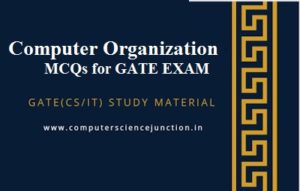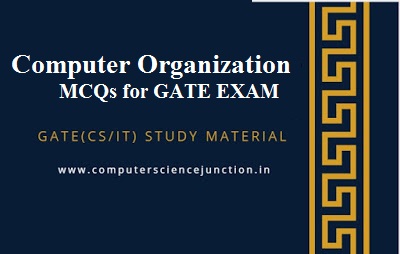Table of Contents
Computer Organization MCQ for GATE Exam
This computer organization mcq based tutorial provides some practice questions for GATE CS/IT Exam. Computer organization and architecture is an important subject for GATE CSE Exam.
It consist of approx. 8-10 marks questions every year in GATE Exam. Here in this tutorial we discussed some computer organization mcq for GATE EXAM practice from different topics of this subjects.
Also Read – The Wendy Williams Show Final Episode
Frequently Asked Questions
These computer organization mcq are generally based on the following concepts of the computer organization and architecture subject. Computer science graduate should know the answers of following questions and concepts in order to solve these computer organization gate questions.
- What is Cache Memory ?
- What is locality of reference ?
- What is difference between temporal locality and spatial locality ?
- How to compute Speed Up in pipe lining ?
- What are different cache mapping techniques ?
- What are different phase of instruction?
- What do you understand by bootstrap loader ?
Computer Organization MCQ for GATE Exam
Some practice questions from computer organization and architecture subject for GATE Exam are as follow –
Q1. More than one word is put in one cache block to
(a) Exploit temporal locality references in a program
(b) Exploit spatial locality references in a program
(c) Reduce miss penalty
(d) All of these
Solution: Option (b)
Q2. A pipeline P is found to provide a speedup of 6.16 when operating at 100 MHz and an efficiency of 88 percent. How many stages does P have?
Solution: We know that Speed Up = Number of Stages * Efficiency
So number of Stages = Speed Up/ Efficiency
= 6.16/0.88 = 7
Q3. How big is a four way set associative cache memory with a block size of 64 Bytes and containing 1024 sets?
Solution: Total size of cache memory is 262144 Bytes.
Explanation : Since memory is 4 way associative and it consist of 1024 sets . It means there will be four blocks in each set. So total number of blocks in memory will be 1024 * 4 it means 4096 blocks. This is given that size of each block is 64 Bytes. SO total size of memory will be 4096*64 = 262144 Bytes
Q4. A five stage pipeline has a clock cycle time of 5ns. If the non-pipeline clock is also of the same duration than what is the speed up for 75% of pipeline efficiency?
Solution: From 3.863 To 3.638
Explanation:
Non-pipeline: 5 × 5 = 25
Pipeline – 5 For 100%−255=5 For 75%−75100×5=3.75
Q5. A tiny bootstrap loader program is situated in
(a) Hard disk (b) ROM
(c) BIOS (d) None of these
Solution: Option (b)
Explanation : Bootstrap Loader is a program which is stored in ROM. When we power on our computer system then at first Bootstrap Loader is activated and its load the operating system from hard disk to main memory.
Since ROM is a non volatile memory in which data is remain stored even after switched off the power. So Boot Strap Loader is stored in ROM.
Also Practice – Computer Networks Gate Questions and Answers

Q6. If a cache access requires one clock cycle and handling cache misses stalls the processor for an additional five cycles, which of the following cache hit rates comes closest to achieving an average memory access of 2 cycles (in %)?
Solution: 80% will be the hit ratio.
Explanation:
2 cycle average access = (1 cycle for cache) + (1 – hit rate) (5 cycles stall)
2 = 1 + (1-h)*5 = 1 + 5 -5 h
5h = 4
So h = 0.80 = 80 %
Q7. Cache and word addressable main memory system has the following specification
Cache block size = 16 words
Set size = 2 blocks
Number of sets = 128
Number of bits in a word = 32 bits
Cache access time (Tc) = 20ns
Memory access (Tm) = 120ns
Hit (H) = 0.8
Size of main memory address = 21bits
What is the total cache size needed?
(a) (16k + 140) bytes (b) (16k + 320) bytes
(c) (256k + 180) bytes (d) (60k + 300) bytes
Solution: Option (b)
Explanation:
Total size of cache=128×2×16×328 + 128×2×108
128 set, each set 2 block 128 set, each set 2 block
each block 16 words
each word 32 bit
27×2×24×2523+16×2×10=(16K+320)byte
Q8. Consider a machine with 10ns clock and it takes 4 clock cycle per ALU instruction, 5 clock cycle per branch instruction, 6 clock cycle memory instruction. There exists 40% ALU instruction, 20% branch instruction and 40% memory instruction.
What is throughput of pipeline system if overhead is 2ns?
(a) 83MIPS (b) 84MIPS
(c) 85MIPS (d) 86MIPS
Solution: Option (a)
Explanation:
Average access time for non-pipeline system [4×.40+5×.20+.40×6]×10ns=
[1.6+1+2.4]×10ns=5×10ns=50ns
For pipeline system in every clock cycle one instruction will get executed and overhead of 2 nano sec.
So, average time = (10 + 2) ns = 12 ns,
throughput of system 112ns=83 MIPS
Q9. A 5 stage pipeline has the stages IF, ID, OF, PO, WB (Assume that there are no separate data and instruction caches). For the program below, what is/are the hazard(s) possible?
MOV R1,A; R1←μ[A]
MOV R2,A; R2←μ[B]
ADD R1,R2; R1←R1+R2
MOV X,R1; μ[x]←R1
(a) Data Hazard (b) Structural Hazard
(c) Control Hazard (d) Both (a) & (b)
Solution: Option (b)
Q10. An instruction pipeline consists of 4 stages fetch(F), decode(D), execute(E) and write(W). Different instruction spent different number of clock cycles.
The value in the box represents clock cycles taken by instructions in different states.
At what clock cycle, instruction I3, will complete its decoding?
(a) 6th clock cycle (b) 7th clock cycle
(c) 12th clock cycle (d) 13th clock cycle
Solution: Option (b)
Explanation:
At 7th clock cycle I3 will complete its decoding.
Also Practice – Theory of Computation Gate Questions and Answers
Recommended Post
Types of wireless sensor networks
Please provide your feedback or leave comment so that we can improve and provide you a good quality tutorials
If you find this computer organization mcq tutorial useful then please Like and Share the post on Facebook, Twitter, Linkedin through their icons as given below.



